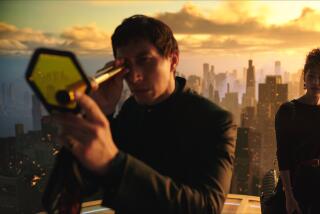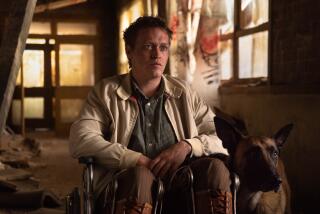A stranger’s take on a strange land
“My goal was to go back to basics and find the joy of believing in a story no matter what,” says Danish filmmaker Lars von Trier about his latest project, “Dogville.” “If someone tells you a story, you have to make an effort to believe in it.
“And when you do, it can really be good.”
That the experience can also be perverse, exhilarating, explosively un-P.C. and unforgettable, it goes without saying. “The sad tale of the township of Dogville,” told in nine chapters and a prologue, is the handiwork of possibly the most controversial European anti-auteur.
Von Trier is on the phone from picturesque Trollhattan, Sweden, where he just started shooting his next film, “Manderlay.” He likes to make movies in sets of three, and “Dogville” is the first in what he has referred to as his American trilogy.
The director is reluctant to make interpretation easy, either. “I like films to raise questions that people will then have to answer themselves. Even I am not really sure what particular theme connects them. Why make films if you’re sure?”
“Dogville,” opening in Los Angeles theaters this week, can be read as a Depression-era allegory about the shabby back side of a purported American Utopia. The credits sequence juxtaposes, with cheerful rudeness, David Bowie’s buoyantly ironic anthem “Young Americans” against Dorothea Lange’s iconic photographs of poverty, for instance. Later, “Dogville’s” omniscient narrator observes that a character “made up for his lack of preparation by lashing out haphazardly in all directions.” In such moments, Von Trier makes it impossible not to see which country he’s skewering.
It shows considerable cheek on the part of an artist who has famously never set foot in the United States. (He suffers from a fear of flying, as well as other phobias that appear as recurring themes in his work.) “You can criticize me for this, but I have a tendency to be inspired by things that I’m not really familiar with and that are quite remote,” the filmmaker says. “It’s much easier that way. You don’t have to work so much doing research -- I already had a remote idea about how America could be -- but of course, you can make a lot of people angry.”
And for some, nothing will be more offensive than the sight of Grace, the film’s protagonist, played with hair-raising abandon by Hollywood megastar Nicole Kidman, spending a fair stretch of the story shackled to a diabolical leash-like contraption and being repeatedly raped.
Even so, there is elegant rhythm and plenty of method to Von Trier’s provocative ways.
At first, fictional Dogville appears to both audience and Grace (a beautiful fugitive pursued by gangsters who is granted sanctuary in the village) to be nothing but a friendly hamlet nestled into a nook of the Rockies, populated by upright people who live winsome lives. It is a place of utilitarian assets -- a verdant apple orchard, an abandoned silver mine, a church with a bell, a watchdog -- many merely outlined on the ground in chalk.
The film’s only discernable lesson is that exploring with any depth this charming slice of Americana is highly dangerous for everybody involved. By the end, the morality of Dogville’s citizens, that of Grace and that of the audience all will have been called into question.
In his next film, “Manderlay,” Grace (played this time around by newcomer Bryce Dallas Howard) stumbles upon another Depression-era small town in Alabama where slavery has yet to be abolished. She sets out to help straighten things, but then “everything, of course, goes awry,” Von Trier says in his cordial, mellow phone manner.
Like the amiable devil from Sartre’s play “No Exit,” he likes to taunt with the possibility that no hell dreamed up by gods could ever measure up to the unspeakable evil that humans readily inflict upon one another.
Because his work has stubbornly, and often in an unexpectedly brilliant manner, probed ethical and moral quandaries, the United Nations recognized Von Trier with a Cinema for Peace prize in 2000. His compulsion to needle the establishment characteristically subverted the awards ceremony.
“I probably offended them because I gave an acceptance speech that was a little cheeky,” he says. “I told them that an apolitical peace prize doesn’t make sense to me. And that first we have to treat each other fairly and divide the world in a just way; I think that’s more important than peace.
“Also, if you are dying of hunger, then you want food more than peace.”
Spoken like a true Marxist.
Ne Lars Trier, the filmmaker picked up the aristocratic article in homage to German directors Erich von Stroheim and Josef von Sternberg. Two other German artists, the agit-lit team of composer Kurt Weill and playwright Bertolt Brecht, are also partly responsible for the highly stylized look and feel of “Dogville.” Von Trier was inspired by musical numbers featured in Brecht’s 1930s plays, paradigm-shifting examples that paired Marxist ideology with cabaret-style decadence.
For “Dogville,” shot entirely with a hand-held camera on a gigantic sound stage, Von Trier says he was obsessed with capturing the stylized miens and the slightly alienating experience of watching theater on television: “I can’t explain why. It’s a feeling I have, like when you need a specific vitamin or mineral. Then again, I always set different kinds of rules and limitations for myself.”
Going back to basics is a journey that the 47-year-old Von Trier has been mapping since the mid-’90s, when he abruptly abandoned the gorgeously baroque expressionism that had characterized his early work. He coauthored the Dogme 95 manifesto -- a public oath he took along with a collective of his Danish peers to banish artifice, decorum and personal taste from filmmaking.
The austere approach yielded harsh new virtues that quickly shoved one of the world’s most backward filmmaking nations to the vanguard of European cinema.
Von Trier visibly rode the crest of the new wave. Using direct storytelling, grainy, realistic photography captured by hand-held cameras and quick-cut editing, he reaped acclaim and infamy with each film.
With the psych-horror hospital soap “The Kingdom,” the subversively and violently anti-bourgeois fantasy “Idiots” and the contrived and heartbreaking melodramas of female crucifixion “Breaking the Waves” and “Dancer in the Dark,” Von Trier proved himself a poet of varied cinematic moods, a sardonic humorist and a filmmaker of stunning visual awareness.
Or, depending on whom you ask, a misanthrope, an impertinent hack -- even a “degenerate” artist, as a furious Time magazine critic labeled him in 2000.
His fiercely independent manner -- he funds his work through a filmmaking enterprise he co-owns, Zentropa Film, which produces the work of fellow filmmakers through an adjacent distribution company -- as well as the intense commitment he requires of his casts are well documented.
Despite past adversarial working relationships with collaborators, Von Trier has many notable admirers. His “Dogville” cast runs the gamut from icon Lauren Bacall to indie luminaries Paul Bettany, Chloe Sevigny and Jeremy Davies, as well as Kidman.
Horror author Stephen King loved Von Trier’s “Kingdom” miniseries so much he decided to write a remake himself for U.S. television. (Von Trier says he finds the idea itself “very funny,” although he hasn’t seen the series, currently running on ABC as “Stephen King’s Kingdom Hospital.”) “I like to be popular with the people I like to be popular with, and I like to be unpopular with the people I like to be unpopular with,” he notes.
When pressed about specifics, he keeps the references to the former vague (“they’re difficult to define, but I know who they are”) but happily names names among the latter.
“I would like to be unpopular with Harvey Weinstein,” he says. “And I think I’ve succeeded.”
More to Read
Only good movies
Get the Indie Focus newsletter, Mark Olsen's weekly guide to the world of cinema.
You may occasionally receive promotional content from the Los Angeles Times.










